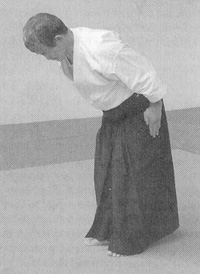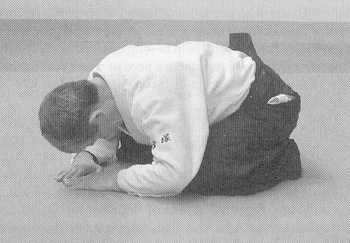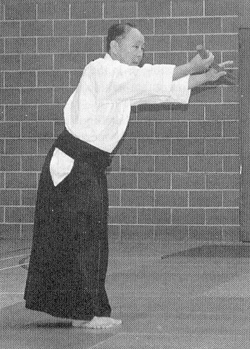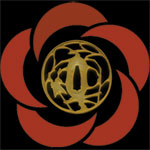

|
|
 |
 |
 |
 |
BASICS FOR BEGINNERS - Part 1, Rei: the bow
by Minoru Kanetsuka, B.A.F. Technical Director, 7th Dan Aikikai Foundation, Tokyo
// Источник: B.A.F. Newsletter,
Июль 2002, No 42
 It is said that in traditional Japanese martial arts practice starts with rei and finishes with rei (rei ni hajimari, rei ni owaru). For Japanese rei means showing respect. As we enter and leave the dojo we show respect with rei to the dojo as a place for earnest study of the Way (in our case the Way of Aiki) and towards kamiza where a portrait of the creator of Aikido, Morihei Ueshiba, is situated. The students show respect to their teacher and the teacher to his/her students at the beginning and end of practice. We show our respect for our training partners with rei by lowering our heads. Rei also symbolizes our humility and appreciation. We should not forget that we cannot practise Aikido by ourselves. We can only practise because there are others willing to practise with us.
It is said that in traditional Japanese martial arts practice starts with rei and finishes with rei (rei ni hajimari, rei ni owaru). For Japanese rei means showing respect. As we enter and leave the dojo we show respect with rei to the dojo as a place for earnest study of the Way (in our case the Way of Aiki) and towards kamiza where a portrait of the creator of Aikido, Morihei Ueshiba, is situated. The students show respect to their teacher and the teacher to his/her students at the beginning and end of practice. We show our respect for our training partners with rei by lowering our heads. Rei also symbolizes our humility and appreciation. We should not forget that we cannot practise Aikido by ourselves. We can only practise because there are others willing to practise with us.
It is important, therefore, that we perform the bow properly. We should never be casual
when performing rei and should do it correctly. And we must maintain this attitude of rei
throughout the practice, from beginning to end. In fact, if we are to derive some more
permanent moral benefit from Aikido, we should seek to take it into our daily lives. That
is the meaning of "do" ( ). ).
Ritsu-rei (standing bow): We should make ritsu-rei from a correct posture. In Japanese this is called chokuritsu shisei or shizentai: 'standing up straight'. In the usual ritsu-rei the upper body is inclined at an angle of about 30° and the hands are placed on the thighs. The head is kept on a line with the spine (and not bowed).
 Za-rei (sitting bow): The correct way to sit on the tatami is in what is called seiza ('correct sitting'). In seiza we keep the back straight, the spine extended vertically, the chin brought in. The knees are about the width of two fists apart. Ideally the feet are set side by side (not one overlapping the other), since this is physiologically better for the body, the vertebrae being perfectly in line. The shoulders are relaxed and the hands are placed on the upper thighs.
Za-rei (sitting bow): The correct way to sit on the tatami is in what is called seiza ('correct sitting'). In seiza we keep the back straight, the spine extended vertically, the chin brought in. The knees are about the width of two fists apart. Ideally the feet are set side by side (not one overlapping the other), since this is physiologically better for the body, the vertebrae being perfectly in line. The shoulders are relaxed and the hands are placed on the upper thighs.
To perform za-rei we incline our upper body without rising from our heels. Our hands are placed on the tatami in front of us with the fingers pointing forwards and slightly inwards, and we bend our
elbows bringing our forearms onto the tatami. However, we should not be supporting our upper body with our arms. (If we are well centred and stable we should be able to incline forward without any need for the support of our arms.)
Commands relating to rei
shomen-ni rei: bow to the front (usually to kamiza);
sensei-ni rei: bow to sensei;
o-tagai-ni rei: bow to each other.
|
|
|
There is also a correct way of making rei when holding a sword.

|
Из словаря
| 正 座 |
сэйдза
seiza |
|
сидеть правильно, прямо
|
|
|
 |
| |
|
 |
  |
 |


 It is said that in traditional Japanese martial arts practice starts with rei and finishes with rei (rei ni hajimari, rei ni owaru). For Japanese rei means showing respect. As we enter and leave the dojo we show respect with rei to the dojo as a place for earnest study of the Way (in our case the Way of Aiki) and towards kamiza where a portrait of the creator of Aikido, Morihei Ueshiba, is situated. The students show respect to their teacher and the teacher to his/her students at the beginning and end of practice. We show our respect for our training partners with rei by lowering our heads. Rei also symbolizes our humility and appreciation. We should not forget that we cannot practise Aikido by ourselves. We can only practise because there are others willing to practise with us.
It is said that in traditional Japanese martial arts practice starts with rei and finishes with rei (rei ni hajimari, rei ni owaru). For Japanese rei means showing respect. As we enter and leave the dojo we show respect with rei to the dojo as a place for earnest study of the Way (in our case the Way of Aiki) and towards kamiza where a portrait of the creator of Aikido, Morihei Ueshiba, is situated. The students show respect to their teacher and the teacher to his/her students at the beginning and end of practice. We show our respect for our training partners with rei by lowering our heads. Rei also symbolizes our humility and appreciation. We should not forget that we cannot practise Aikido by ourselves. We can only practise because there are others willing to practise with us. Za-rei (sitting bow): The correct way to sit on the tatami is in what is called seiza ('correct sitting'). In seiza we keep the back straight, the spine extended vertically, the chin brought in. The knees are about the width of two fists apart. Ideally the feet are set side by side (not one overlapping the other), since this is physiologically better for the body, the vertebrae being perfectly in line. The shoulders are relaxed and the hands are placed on the upper thighs.
Za-rei (sitting bow): The correct way to sit on the tatami is in what is called seiza ('correct sitting'). In seiza we keep the back straight, the spine extended vertically, the chin brought in. The knees are about the width of two fists apart. Ideally the feet are set side by side (not one overlapping the other), since this is physiologically better for the body, the vertebrae being perfectly in line. The shoulders are relaxed and the hands are placed on the upper thighs.